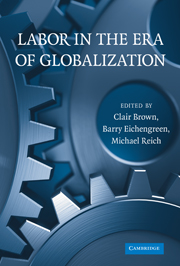Book contents
- Frontmatter
- Contents
- Tables and Figures
- List of Authors and Editors
- Introduction: Labor in the Era of Globalization
- PART ONE POLITICAL ECONOMY AND LABOR MARKET INSTITUTIONS
- PART TWO INSTITUTIONS AND FIRM AND WORKER BEHAVIOR
- PART THREE CONTEMPORARY LABOR–MANAGEMENT RELATIONS
- 7 The New Treaty of Detroit: Are VEBAs Labor's Way Forward?
- 8 Symphony Musicians and Symphony Orchestras
- 9 Wage Effects of Works Councils and Collective Agreements in Germany
- 10 Apprentice Strikes, Pay Structure, and Training in the Twentieth-Century UK Metalworking Industry
- PART FOUR PUBLIC POLICY AND U.S. LABOR-MARKET STRUCTURE
- Index
- References
8 - Symphony Musicians and Symphony Orchestras
Published online by Cambridge University Press: 05 June 2012
- Frontmatter
- Contents
- Tables and Figures
- List of Authors and Editors
- Introduction: Labor in the Era of Globalization
- PART ONE POLITICAL ECONOMY AND LABOR MARKET INSTITUTIONS
- PART TWO INSTITUTIONS AND FIRM AND WORKER BEHAVIOR
- PART THREE CONTEMPORARY LABOR–MANAGEMENT RELATIONS
- 7 The New Treaty of Detroit: Are VEBAs Labor's Way Forward?
- 8 Symphony Musicians and Symphony Orchestras
- 9 Wage Effects of Works Councils and Collective Agreements in Germany
- 10 Apprentice Strikes, Pay Structure, and Training in the Twentieth-Century UK Metalworking Industry
- PART FOUR PUBLIC POLICY AND U.S. LABOR-MARKET STRUCTURE
- Index
- References
Summary
By the standards applied to profit-seeking organizations, symphony orchestras have been a declining industry in the United States over the past two decades. Performance (i.e., earned) revenues have fallen short of performance expenses by ever-increasing amounts, and attendance per concert is declining for virtually all types of concerts, despite steady increases in the proportion of the population with a college education (i.e., the demographic most likely to attend concerts). Like universities, symphony orchestras and other performing-arts organizations have almost always required contributed support and investment income from endowments to offset the gap between performance revenues and expenses. But in the past twenty years, there have been indications that these traditional sources of nonperformance income often fail to achieve overall financial balance for orchestras.
Symphony orchestras are also one of the last bastions of union representation in the United States. The working conditions of musicians in all but two of the top sixty orchestras are governed by collective-bargaining agreements, and the two exceptions are labor cooperatives. This chapter investigates the relationship between these two facts: the extent to which the economic difficulties faced by symphony orchestras reflect collectively bargained wage increases and work rules. The setting also provides an opportunity to address much broader questions, including the nature of collective bargaining when the employer is a nonprofit organization and the role of unions in declining industries.
- Type
- Chapter
- Information
- Labor in the Era of Globalization , pp. 264 - 294Publisher: Cambridge University PressPrint publication year: 2009

